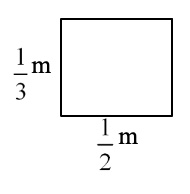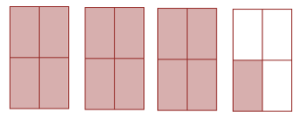Unit 5: Common Fractions & Decimals
Book Five Final Review
You will now practice all the skills you learned in Book 5. You can use this as a review for your final test.
If you can’t remember how to do a question, go back to the lesson on this topic to refresh your memory. The unit and topic for where each question came from is listed next to the question.
Example: 1A means Unit 1, Topic A
1-A
- Write in lowest terms the common fractions to describe the shaded portion of each shape.
- Draw your own fractions.
- [latex]\dfrac{1}{5}[/latex]
- [latex]\dfrac{3}{7}[/latex]
- Answer the questions using a common fraction, in lowest terms.
- Rattan ran for 40 minutes. What fraction of an hour did he run?
- Oliver answered 23 of the 27 questions on his test. What fraction of questions did he answer?
- Belle got 49 marks on the test. The test was out of 56. What was her score?
1-B
- Identify each fraction by writing: proper fraction, improper fraction, or mixed number next to each fraction.
- [latex]\dfrac{5}{2}[/latex]
- [latex]2\dfrac{1}{3}[/latex]
- [latex]\dfrac{4}{5}[/latex]
- [latex]\dfrac{7}{3}[/latex]
- Write the improper fraction and the equivalent mixed number that describe the shaded part in each drawing.
- Rename each improper fraction into a mixed number.
- [latex]\dfrac{11}{5} =[/latex]
- [latex]\dfrac{15}{4} =[/latex]
- [latex]\dfrac{19}{6} =[/latex]
- Rename each whole number as an improper fraction. Use the denominator given to you.
- [latex]5=\dfrac{ }{2}[/latex]
- [latex]3=\dfrac{ }{5}[/latex]
- [latex]8=\dfrac{ }{3}[/latex]
- Rename each mixed number as an improper fraction
- [latex]2\dfrac{3}{8} =[/latex]
- [latex]6\dfrac{5}{9} =[/latex]
- [latex]1\dfrac{2}{3} =[/latex]
2-A
- Find the factors, common factors and the Greatest Common Factor (GCF) Fraction Factors Common Factors GCF
- [latex]\dfrac{4}{22}[/latex]
- [latex]\dfrac{12}{48}[/latex]
- [latex]\dfrac{27}{36}[/latex]
- [latex]\dfrac{12}{40}[/latex]
- Express each fraction in lowest terms.
- [latex]\dfrac{7}{21} =[/latex]
- [latex]\dfrac{9}{24} =[/latex]
- [latex]\dfrac{10}{250} =[/latex]
- [latex]\dfrac{12}{36} =[/latex]
- State if each pair of fractions is equivalent (=) or not equivalent (≠) by placing the correct sign between them.
- [latex]\dfrac{3}{4}[/latex] [latex]\dfrac{31}{42}[/latex]
- [latex]\dfrac{1}{7}[/latex] [latex]\dfrac{5}{35}[/latex]
- [latex]\dfrac{4}{13}[/latex] [latex]\dfrac{6}{39}[/latex]
- [latex]\dfrac{1}{3}[/latex] [latex]\dfrac{11}{13}[/latex]
- Round to the nearest whole number.
- [latex]2\dfrac{1}{6} =[/latex]
- [latex]1\dfrac{4}{5} =[/latex]
- [latex]\dfrac{3}{5} =[/latex]
3-A
- Write the multiplication equation you would use to find the answer to the question. Do not calculate the answer.
- Joan peeled [latex]\tfrac{3}{4}[/latex] of the 35 kilograms of apples. How many kilograms of apples did Joan peel?
- There are 16 bottles of ketchup in the restaurant. They are each full. How many full bottles of ketchup would there be if all ketchup bottles were put together?
- Half a recipe that needs [latex]2\dfrac{2}{3}[/latex]cups of sugar.
- The community pool has a capacity of 150 swimmers. The pool is full. How many swimmers are there?
- Find the products. Make sure your answers are in lowest terms.
- [latex]\dfrac{1}{3}\times\dfrac{4}{5} =[/latex]
- [latex]\dfrac{1}{3}\text{ of }34 =[/latex]
- [latex]4\times\dfrac{3}{5} =[/latex]
- [latex]\dfrac{5}{7}\text{ of }1\dfrac{1}{5} =[/latex]
- [latex]2\dfrac{1}{2}\times7\dfrac{1}{2} =[/latex]
- [latex]\dfrac{3}{4}\times\dfrac{1}{7}\times4\dfrac{5}{9} =[/latex]
- Solve the following word problems.
- Emma saves [latex]\tfrac{1}{5}[/latex] of her income for the down payment on a house. If her annual income is $34458.00, how much can she save in one year?
- [latex]\tfrac{1}{3}[/latex]of the students at one Vancouver college speaks a language other than English. [latex]\tfrac{3}{4}[/latex] of those students are enrolled in English Language Learning (ELL). What fraction of the students are studying ELL?
- A recipe calls for [latex]1\tfrac{1}{2}[/latex] cups of sugar. How much sugar should be used if the recipe is being tripled?
- Find the area of the rectangle.

- A corner store sells 2345 items in one day. [latex]\tfrac{4}{5}[/latex] of those items are junk food. How many of those items are junk food?
- Divide the following fractions. Show all your work, and make sure your answers are in the lowest terms.
- [latex]\dfrac{1}{3}÷\dfrac{3}{4} =[/latex]
- [latex]\dfrac{1}{2}÷\dfrac{3}{5} =[/latex]
- [latex]\dfrac{3}{5}÷ 9 =[/latex]
- [latex]3\dfrac{2}{3}÷\dfrac{1}{2} =[/latex]
- [latex]5\dfrac{1}{5}÷\dfrac{6}{7} =[/latex]
- [latex]4\dfrac{1}{3}÷2\dfrac{2}{5} =[/latex]
- Solve the following word problems:
- Kathy worked on planting garlic last weekend. It took her [latex]3\tfrac{1}{2}[/latex] minutes to plant one row. How many rows did she plant in [latex]\tfrac{1}{3}[/latex] of an hour? (one hour = 60 minutes)
- Nicole knits socks in the evenings. It takes her [latex]7\tfrac{1}{3}[/latex] hours to knit one sock. How many hours does it take to knit a pair of socks (that is 2 socks)?
- Last week Nicole knit for a total of [latex]27\tfrac{1}{2}[/latex] hours. Approximately how many socks could she knit in that time? (To get an approximate, round your numbers to whole numbers first).
- A baking sheet is [latex]39\tfrac{3}{5}[/latex] cm by [latex]18\tfrac{1}{4}[/latex] cm. Find its area.
4-A
- Add these common fractions. Make sure to reduce your answer to the lowest terms.
- [latex]\begin{array}{rr}&\dfrac{1}{5}\\+&\dfrac{4}{5}\\\hline\end{array}[/latex]
- [latex]\begin{array}{rr}&\dfrac{3}{5}\\+&\dfrac{6}{7}\\\hline\end{array}[/latex]
- [latex]\dfrac{2}{7} + \dfrac{3}{4} =[/latex]
- [latex]\dfrac{2}{3} + \dfrac{5}{9} =[/latex]
- [latex]\begin{array}{rr}&\dfrac{5}{12}\\+&\dfrac{5}{8}\\\hline\end{array}[/latex]
- [latex]\begin{array}{rr}&\dfrac{2}{3}\\+&\dfrac{5}{6}\\\hline\end{array}[/latex]
- Add these mixed numbers, express the sum in the lowest terms.
- [latex]\begin{array}{rr}&4\dfrac{2}{5}\\+&7\dfrac{4}{7}\\\hline\end{array}[/latex]
- [latex]2\dfrac{1}{3} + 4\dfrac{3}{4} =[/latex]
- [latex]1\dfrac{2}{3} + 3\dfrac{1}{2} + 3\dfrac{3}{4} =[/latex]
- [latex]4\dfrac{1}{8} + 1\dfrac{1}{4} =[/latex]
- [latex]\begin{array}{rr}&4\dfrac{1}{9}\\+&2\dfrac{2}{3}\\\hline\end{array}[/latex]
- [latex]\begin{array}{rr}&2\dfrac{7}{15}\\+&10\dfrac{1}{5}\\\hline\end{array}[/latex]
- Subtract these common fractions, express the sum in the lowest terms.
- [latex]\begin{array}{rr}&\dfrac{5}{12}\\−&\dfrac{1}{3}\\\hline\end{array}[/latex]
- [latex]\begin{array}{rr}&\dfrac{5}{6}\\−&\dfrac{3}{4}\\\hline\end{array}[/latex]
- [latex]\begin{array}{rr}&\dfrac{1}{2}\\−&\dfrac{9}{24}\\\hline\end{array}[/latex]
- [latex]\dfrac{4}{5} − \dfrac{1}{4} =[/latex]
- [latex]\dfrac{30}{35} − \dfrac{2}{5} =[/latex]
- [latex]\dfrac{1}{2} − \dfrac{5}{12} =[/latex]
- Subtract these mixed numbers, express the sum in the lowest terms.
- [latex]\begin{array}{rr}&7\dfrac{2}{3}\\−&2\dfrac{1}{6}\\\hline\end{array}[/latex]
- [latex]\begin{array}{rr}&2\dfrac{4}{7}\\−&1\dfrac{5}{21}\\\hline\end{array}[/latex]
- [latex]\begin{array}{rr}&9\dfrac{1}{5}\\−&4\dfrac{4}{25}\\\hline\end{array}[/latex]
- [latex]3\dfrac{1}{2} − 1\dfrac{4}{7} =[/latex]
- [latex]6\dfrac{1}{2} − 3\dfrac{3}{4} =[/latex]
- [latex]5\dfrac{1}{2} − 2\dfrac{7}{8} =[/latex]
- Solve the following word problems.
- A concrete contractor needs [latex]6\tfrac{1}{3}[/latex] metres of wire mesh for a concrete walkway and [latex]12\tfrac{3}{8}[/latex] metres of wire mesh for a driveway. If the contractor starts with a roll that is [latex]54\tfrac{1}{4}[/latex] metres long, how much wire mesh is left at the end of the two jobs?
- Frida and Sean collect returnable bottles and cans. Frida has [latex]3\tfrac{1}{3}[/latex] bags of returnables. Sean has [latex]4\tfrac{1}{2}[/latex] bags to return. How much more does Sean have than Frida?
- Mike bought [latex]5\tfrac{1}{4}[/latex] metres of cotton to sew three shirts. Each shirt took [latex]1\tfrac{3}{5}[/latex] m of material. How much cotton is left over?
- A freight container is loaded with 3 groups of products. Group A weighs [latex]58\tfrac{1}{2}[/latex] tons, Group B weighs [latex]23\tfrac{5}{8}[/latex] tons and Group C weighs [latex]29\tfrac{1}{4}[/latex] tons. Find the weight of the products.
- If the loaded container is question d) is [latex]189\tfrac{3}{5}[/latex] tons, what is the weight of the empty container?
5-A
- Write as a common fraction in lowest terms.
- 0.75
- 0.16
- 0.1
- 0.4
- 1.6
- 2.625
- 3.3
- 0.125
- Write as decimals. Round your answer to 3 decimal places.
- [latex]\dfrac{3}{8}[/latex]
- [latex]\dfrac{1}{3}[/latex]
- [latex]\dfrac{3}{4}[/latex]
- [latex]\dfrac{1}{20}[/latex]
- [latex]\dfrac{1}{8}[/latex]
- [latex]1\dfrac{2}{3}[/latex]
- [latex]\dfrac{1}{5}[/latex]
- [latex]\dfrac{6}{6}[/latex]
- Compare the following fractions, use < or >.
- [latex]\dfrac{2}{3}[/latex] [latex]\dfrac{1}{4}[/latex]
- [latex]\dfrac{2}{5}[/latex] [latex]\dfrac{4}{7}[/latex]
- [latex]\dfrac{5}{9}[/latex] [latex]\dfrac{1}{3}[/latex]
- [latex]\dfrac{7}{12}[/latex] [latex]\dfrac{2}{3}[/latex]
- Compare the following fractions to decimals. Use < , >, or =.
- [latex]\dfrac{1}{2}[/latex] [latex]0.5[/latex]
- [latex]\dfrac{2}{3}[/latex] [latex]0.625[/latex]
- [latex]0.125[/latex] [latex]\dfrac{1}{8}[/latex]
- [latex]\dfrac{4}{9}[/latex] [latex]0.6[/latex]
- [latex]3.45[/latex] [latex]\dfrac{1}{8}[/latex]
- [latex]\dfrac{1}{5}[/latex] [latex]0.3[/latex]
Answers to Book Five Final Review
- Write in lowest terms the common fractions to describe the shaded portion of each shape.
- [latex]\dfrac{3}{4}[/latex]
- [latex]\dfrac{1}{4}[/latex]
- [latex]\dfrac{1}{2}[/latex]
- Draw your own fractions.
- Answer the questions using a common fraction, in lowest terms.
- [latex]\dfrac{2}{3}[/latex]
- [latex]\dfrac{23}{27}[/latex]
- [latex]\dfrac{7}{8}[/latex]
- Identify each fraction by writing: proper fraction, improper fraction, or mixed number next to each fraction.
- improper fraction
- mixed number
- proper fraction
- improper fraction
- Write the improper fraction and the equivalent mixed number that describe the shaded part in each drawing.
- [latex]\dfrac{27}{8}[/latex], [latex]3\dfrac{3}{8}[/latex]
- [latex]\dfrac{13}{4}[/latex], [latex]3\dfrac{1}{4}[/latex]
- Rename each improper fraction into a mixed number.
- [latex]2\dfrac{1}{5}[/latex]
- [latex]3\dfrac{3}{4}[/latex]
- [latex]3\dfrac{1}{6}[/latex]
- Rename each whole number as an improper fraction. Use the denominator given to you.
- [latex]\dfrac{10}{2}[/latex]
- [latex]\dfrac{15}{5}[/latex]
- [latex]\dfrac{24}{3}[/latex]
- Rename each mixed number as an improper fraction.
- [latex]\dfrac{19}{8}[/latex]
- [latex]\dfrac{59}{9}[/latex]
- [latex]\dfrac{5}{3}[/latex]
- Find the factors, common factors and the Greatest Common Factor (G.C.F.).
Fraction Factors Common Factors G.C.F. a [latex]\dfrac{4}{22}[/latex] 1, 2, 4 1, 2, 11, 22
2 2 b [latex]\dfrac{12}{48}[/latex] 1, 2, 3, 4, 6, 12 1, 2, 3, 4, 6, 8, 12, 16, 24, 48
2, 3, 4, 6, 12 12 c [latex]\dfrac{27}{36}[/latex] 1, 3, 9, 27 1, 2, 3, 4, 6, 9, 12, 18, 36
3, 9 9 d [latex]\dfrac{12}{40}[/latex] 1, 2, 3, 4, 6, 12 1, 2, 4, 5, 8, 10, 20, 40
2, 4 4 - Express each fraction in lowest terms.
- [latex]\dfrac{1}{3}[/latex]
- [latex]\dfrac{3}{8}[/latex]
- [latex]\dfrac{1}{25}[/latex]
- [latex]\dfrac{1}{3}[/latex]
- State if each pair of fractions is equivalent (=) or not equivalent (≠) by placing the correct sign between them.
- ≠
- =
- ≠
- ≠
- Round to the nearest whole number.
- 2
- 2
- 1
- Write the multiplication equation you would use to find the answer to the question.
- [latex]\dfrac{3}{4}\times\dfrac{35}{1}[/latex]
- [latex]16\times\dfrac{1}{4}[/latex]
- [latex]\dfrac{1}{2}\times\dfrac{22}{3}[/latex]
- [latex]150\times\dfrac{1}{5}[/latex]
- Find the products. Make sure your answers are in lowest terms.
- [latex]\dfrac{4}{15}[/latex]
- [latex]11\dfrac{1}{3}[/latex]
- [latex]2\dfrac{2}{5}[/latex]
- [latex]\dfrac{6}{7}[/latex]
- [latex]18\dfrac{3}{4}[/latex]
- [latex]\dfrac{41}{84}[/latex]
- Solve the following word problems.
- $6891[latex]\tfrac{3}{5}[/latex]
- [latex]\tfrac{1}{4}[/latex]
- [latex]4\tfrac{1}{2}[/latex] cups
- [latex]\tfrac{1}{6}[/latex] m2
- 1876
- Divide the following fractions. Show all your work, and make sure your answers are in the lowest terms.
- [latex]\dfrac{4}{9}[/latex]
- [latex]\dfrac{5}{6}[/latex]
- [latex]\dfrac{1}{15}[/latex]
- [latex]7\dfrac{1}{3}[/latex]
- [latex]6\dfrac{1}{15}[/latex]
- [latex]1\dfrac{29}{36}[/latex]
- Solve the following word problems.
- [latex]5\tfrac{5}{7}[/latex] rows
- [latex]14\tfrac{2}{3}[/latex] hours
- [latex]4[/latex] socks
- [latex]8\tfrac{2}{3}[/latex] km
- [latex]722\tfrac{7}{10}[/latex] cm2
- Add these common fractions, make sure to reduce your answer to the lowest terms.
- [latex]1[/latex]
- [latex]1\dfrac{16}{35}[/latex]
- [latex]1\dfrac{1}{28}[/latex]
- [latex]1\dfrac{2}{9}[/latex]
- [latex]1\dfrac{1}{24}[/latex]
- [latex]1\dfrac{1}{2}[/latex]
- Add these mixed numbers, express the sum in the lowest terms.
- [latex]11\dfrac{34}{35}[/latex]
- [latex]7\dfrac{1}{12}[/latex]
- [latex]8\dfrac{11}{12}[/latex]
- [latex]5\dfrac{3}{8}[/latex]
- [latex]6\dfrac{7}{9}[/latex]
- [latex]12\dfrac{2}{3}[/latex]
- Subtract these common fractions. Express your answer in lowest terms.
- [latex]\dfrac{1}{12}[/latex]
- [latex]\dfrac{1}{12}[/latex]
- [latex]\dfrac{1}{8}[/latex]
- [latex]\dfrac{11}{20}[/latex]
- [latex]\dfrac{16}{35}[/latex]
- [latex]\dfrac{1}{12}[/latex]
- Subtract these mixed numbers, express your answer in lowest terms.
- [latex]5\dfrac{1}{2}[/latex]
- [latex]1\dfrac{1}{3}[/latex]
- [latex]5\dfrac{1}{25}[/latex]
- [latex]1\dfrac{13}{14}[/latex]
- [latex]2\dfrac{3}{8}[/latex]
- [latex]2\dfrac{5}{8}[/latex]
- Solve the following word problems.
- [latex]35\tfrac{13}{24}[/latex] m
- [latex]1\tfrac{1}{6}[/latex] more
- [latex]\tfrac{9}{20}[/latex] metres
- [latex]111\tfrac{3}{8}[/latex] tonnes
- [latex]78\tfrac{3}{8}[/latex] tonnes
- Write as a common fraction in lowest terms.
- [latex]\dfrac{3}{4}[/latex]
- [latex]\dfrac{1}{6}[/latex]
- [latex]\dfrac{1}{10}[/latex]
- [latex]\dfrac{2}{5}[/latex]
- [latex]1\dfrac{3}{5}[/latex]
- [latex]2\dfrac{5}{8}[/latex]
- [latex]3\dfrac{1}{3}[/latex]
- [latex]\dfrac{1}{8}[/latex]
- Write as decimals. Round your answer to 3 decimal places.
- [latex]0.375[/latex]
- [latex]0.\overline{3}[/latex]
- [latex]0.75[/latex]
- [latex]0.05[/latex]
- [latex]0.125[/latex]
- [latex]1.\overline{6}[/latex]
- [latex]0.2[/latex]
- [latex]1[/latex]
- Compare the following fractions, use < or >.
- >
- <
- >
- <
- Compare the following fractions to decimals. Use < , >, or =.
- =
- >
- =
- <
- >
- <






